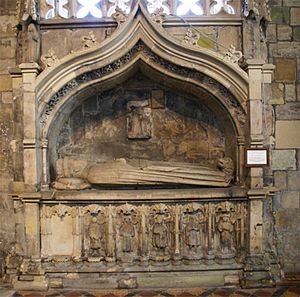Archibald Douglas, 5th Earl of Douglas facts for kids
Quick facts for kids
Archibald Douglas
|
|
|---|---|

Tomb of the Earl of Douglas
|
|
| Born | c. 1391 |
| Died | 26 June 1439 Restalrig, Midlothian
|
| Resting place | St Bride's Kirk, Douglas, South Lanarkshire |
| Title | Earl of Douglas Duke of Touraine (de jure) Earl of Wigton Lord of Galloway Lord of Bothwell, Selkirk and Ettrick Forest, Eskdale, Lauderdale, Liddesdale and Annandale Count of Longueville Seigneur de Dun-le-roi |
| Spouse(s) | Euphemia Graham |
| Children | William Douglas, 6th Earl of Douglas Margaret Douglas, Fair Lady of Galloway David Douglas |
| Parents |
|
| Family | Clan Douglas |
Archibald Douglas, 5th Earl of Douglas (born around 1391 – died June 26, 1439) was an important Scottish nobleman and military leader. He played a big role in Scottish politics and also fought in the Hundred Years' War in France.
Contents
Life of Archibald Douglas
Early Life and Many Titles
Archibald Douglas was the son of Archibald Douglas, 4th Earl of Douglas and Margaret Stewart. His mother was the oldest daughter of King Robert III of Scotland. This made him part of a very powerful family.
He held many important titles in Scotland, showing how much land and influence he had. These included Earl of Douglas and Wigtown, Lord of Galloway, and Lord of many other areas like Bothwell and Annandale. He also had titles in France, such as Duke of Touraine and Count of Longueville. In France, people sometimes called him Victon, which was a way of saying "Wigtown."
Fighting in France
Archibald Douglas fought alongside the French army in a famous battle called Baugé in 1421. After this battle, he was given the title of Count of Longueville in Normandy, France.
In 1424, he inherited his father's Scottish and French titles. Even though he was the Duke of Touraine, he didn't actually use the lands that came with that French title.
Serving the King
Douglas was an ambassador to England in 1424. An ambassador is like a special messenger or representative for a country. His job was to help with the return of King James I of Scotland, who had been held captive in England.
In 1425, he was part of a group of important knights and nobles. This group decided that Murdoch Stewart, Duke of Albany, and two of his sons were disloyal to the king. This decision led to the Albany family losing their power and influence in Scotland.
After King James I was killed in 1437, Archibald Douglas became the Lieutenant General of Scotland. This meant he was in charge of the country as a Regent. He held this important position while the new king, James II, was still a child. He served as Regent until his own death in 1439.
Death and Burial
Archibald Douglas died from a fever in Restalrig, which is in Midlothian, Scotland. He was buried at Douglas, a town in South Lanarkshire.
Family and Children
Marriage and Descendants
Between 1423 and 1425, Archibald Douglas married Lady Eupheme Graham. She was the daughter of Patrick Graham, who was the Earl of Strathearn. Archibald and Eupheme had three children together:
- William Douglas (born around 1424 – died 1440). He became the 6th Earl of Douglas for a short time after his father.
- Margaret Douglas, Fair Lady of Galloway (born before 1435 – died 1475).
- David Douglas (born before 1430 – died 1440).
The Black Dinner
Sadly, both of Archibald's sons, William and David, lost their lives in 1440. They were accused of false charges at Edinburgh Castle in front of the young King James II. This event is often called the 'Black Dinner'. It greatly weakened the power of the 'Black' Douglas family.
After this, some of the Douglas lands, like Annandale and Bothwell, became part of the crown's property. Galloway went to Margaret Douglas, Archibald's daughter. The main Douglas lands and the title of Earl passed to William's great-uncle, James Douglas, Earl of Avondale.

